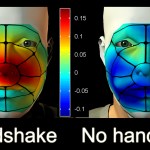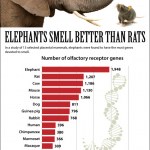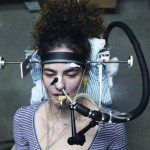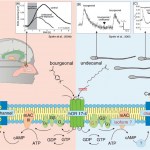smell
Front view of a star-nosed mole. Credit: Ken Catania
Dr. Kenneth Catania from Vanderbilt University presented his work with star-nosed moles at the Experimental Biology meeting last month in Chicago. These animals are really cool. Here are some facts from Dr. Catania about these crazy-looking creatures you may not know:
If participating in a bug-eating contest, they would win hands down every time because they are the fastest-eating mammal known. In fact, they can identify and consume a bug in a record less than two tenths of a millisecond. This is possible…
Today's guest blogger is Idan Frumin, a student in the group of Prof. Noam Sobel in the Neurobiology Department. Their research on the transmission of odor compounds while shaking hands appears today in eLife.
It all started one day after lunch, sometime back in 2011. We sat in the lab’s living room (Yeah, we have a living room. And a bedroom. And a blind pet cat. But that’s a different story), when Noam asked – ever wonder why people shake hands?
– To show you don’t have a saber up your sleeve – I immediately retorted.
– But that seems odd, doesn’t it? After all, we’re not in the…
Image from Wikimedia Commons, Author: Alvesgaspar
New research from the University of Lincoln, UK suggests that cats may prefer to find food using their eyes as opposed to their nose. The preference for vision vs. smell was tested in 6 cats placed in a maze that required cats to make decisions about which way to go based on either images or smells. The researchers observed that 4 out of 6 of the cats chose the visual as opposed to the smell cues to obtain their rewards (food). One cat showed a preference for using its nose, whereas one cat showed no clear …
Get rid of your addictions while you sleep? Weizmann Institute researcher Dr. Anat Arzi is not promising this yet, but she and Prof. Noam Sobel have shown that changing bad habits through sleep conditioning could someday be possible. After just one session in the Neurobiology Department’s sleep lab, volunteers reported smoking on average 30% fewer cigarettes over the course of a week.
Volunteers given the same conditioning while awake did not reduce their nicotine consumption.
Arzi and Sobel had first demonstrated true sleep learning in 2012. This is the same conditioning that Pavlov…
Like Aesop's fable, rats have another reason to be envious of elephants. Elephants also have significantly more genes that can detect different smells (i.e. olfactory receptor genes) than other super-sniffers like rats and dogs. In fact, compared to 13 other species, African elephants have 1,948 genes related to smell putting them ahead of the previous record holder, rats that only have about half as many genes. Primates have much fewer with only 296-396 of these olfactory receptor genes. Interestingly, the common ancestor of mammals had 781 olfactory genes, meaning that primates have lost…
New research published in Science Reports by Strauch et al., shows that fruit flies can tell the difference between cancerous and healthy cells. The researchers recorded calcium patterns indicative of neuronal activity that was stimulated in response to various odors emitted by healthy and cancerous cells. Because cells with cancer differ metabolically from healthy cells, they emit different volatile compounds that can be detected by olfactory receptor neurons on the antennae of fruit flies. When exposed to breast cancer cells or healthy cells, the flies exhibited different patterns in…
Researchers have actually trained a beagle named Cliff to detect the intestinal bacteria Clostridium difficile on patients and in stool samples that were collected from infected patients in the Netherlands. This infection is common in hospitals and long-term treatment facilities. Infection with the contagious C. diff results in diarrhea that has been responsible for the deaths of up to 14,000 Americans each year. Having a dog sniff out the infection may seem absurd until you consider it can take up to a week to detect the infection using traditional laboratory techniques. Being able…
Weizmann Institute scientists have created a “white smell.” Think about white light or white noise: Each mixes a bunch of different waves together from various parts of the visual or audible spectrum. Those wavelengths combine such that we perceive that unobtrusive light or sound we call “white.”
How do smells fit into this scenario? Prof. Noam Sobel and his group have already shown that smells have their own spectrum – ranging from pleasant to unpleasant – and that this relates to the chemical structure of the odor molecules. Is this spectrum truly analogous to that of light or sound? That…
“Imagine that you wake up in the morning feeling nothing special, yet you find yourself inexplicably behaving just a bit differently during the day. For example, you take a sniff every time you hear a tone,” says Prof. Noam Sobel. Of course, the people this actually happened to knew they had volunteered for a sleep experiment in Sobel’s lab. They knew that their sleep patterns had been closely monitored. But they had no recall, whatsoever, of the “lesson” they had learned while snoring peacefully. It was the sniffing that gave it away: While asleep, they had undergone conditioning to…
The olfactory membranes in your nose are densely packed with smell receptors. These receptors come in some 400 different subtypes; complex odors like that of rose petals can waft around 175 distinct kinds of odor molecules in the direction of your nose. In other words, the number of discrete odors we can perceive runs to the tens of thousands. No wonder scientists had thought that the whole smell arrangement was basically random.
But research by Prof. Noam Sobel and his team in the Weizmann Neurobiology Department is bringing our noses into line with our other sensory organs. The arrangement…
So I was browsing the internet for info on G-protein coupled receptors and ended up finding some interesting facts about sperm. It turns out sperm don't just swim blindly, hoping to randomly bump into eggs. Instead, like bacteria, sperm can sense their chemical environment and adjust their swimming accordingly. Sperm have a sense of smell.
The (g-protein coupled) olfactory receptors in our noses that activate our sense of smell were discovered in 1991, an amazing discovery that earned the 2004 Nobel prize for physiology or medicine. The receptors sit on the surface of the cells up high in our…
Cells are constantly jibber jabbering, sending messages to each other to coordinate behavior, both within a population of single-celled organisms or between cells of an individual multicellular organism. Most of these signals are chemicals that float around in the liquid that surrounds the cells but there recently has been an increased appreciation for cells' sense of "smell"--how cells respond to chemicals that are present as gasses.
A brand new paper outlines the discovery of "olfaction" in a species of bacteria, Bacillus licheniformis. Trying to save space on a 96 well dish by putting…
The English language is full of metaphors linking moral purity to both physical cleanliness and brightness. We speak of "clean consciences", "pure thoughts" and "dirty thieves". We're suspicious of "shady behaviour" and we use light and darkness to symbolise good and evil. But there is more to these metaphors than we might imagine. The mere scent of a clean-smelling room can take people down a virtuous road, compelling them to choose generosity over greed and charity over apathy. Meanwhile, the darkness of a dimmed room or a pair of sunglasses can compel people towards selfishness and…
Women May Be Sniffing Out Biologically-relevant Information From Underarm Sweat:
Sniffed alone, the underarm odors smelled equally strong to men and women. When fragrance was introduced, only two of 32 scents successfully blocked underarm odor when women were doing the smelling; in contrast, 19 fragrances significantly reduced the strength of underarm odor for men.
...
Not only were women better smellers the men, but male odors were harder to block than female odors. Even though underarm odors from the two sexes didn't differ in how strong they smelled, only
So women have a better sense of…
In January, scientists published a paper which found that women's brains reacted differently to sweat from aroused men. This another study showing the mounting evidence that human beings, although unconsciously, communicate information via olfactory cues that our brains are able to interpret. Now another study has shown that such olfactory cues can actually affect our interpretation of other people. The study, published in Psychological Science, has found that women who smelled 'fearful sweat' actually perceived neutral facial expressions as more fearful.
People have thrown around the phrase…
Pregnant women are generally advised to avoid drinking alcohol and for good reason - exposing an unborn baby to alcohol can lead to a range of physical and mental problems from hyperactivity and learning problems to stunted growth, abnormal development of the head, and mental retardation.
But alcohol also has much subtler effects on a foetus. Some scientists have suggested that people who get their first taste of alcohol through their mother's placenta are more likely to develop a taste for it in later life. This sleeper effect is a long-lasting one - exposure to alcohol in the womb has been…
Ok, the consistent reader of this blog can't help but notice that I am a sucker when it comes to unique studies about human relationships and the trappings that go with them. The biological basis and interaction with behavior is simply fascinating to me. This is why I had to report on a study that showed even without knowing it, women's brains picked up on the smell of arousal in men's sweat. And, following that vein, I can't help but write about a new olfactory study, which found that a woman's passion for her man affects her ability to identify the smell of other men in her life.…
A ScienceFriday video podcast from over a year ago on how the star-nosed mole and other mammals can actually sniff for prey underwater.
I wonder if this is what my dog is doing and she sticks her nose to the base of the door and snorts as people approach.
Bad experiences can be powerful learning aids for our sense of smell. A new study reveals that electric shocks can make people more sensitive to the differences between very similar chemicals that previously smelled identical.
Every day, thousands of different molecules waft past our nose. Many of these are uncannily similar and some are more important to others. Wen Li from Northwestern University wanted to see how people learn to distinguish the critical smells from the unimportant ones.
Smell the difference
Working in the lab of smell guru, Jay Gottfried, Li attempted to train 12…








